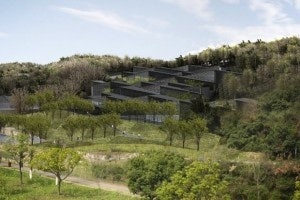“The Soil Of The Tea Gardens Is Actually Transformed Into The Architecture”#

Following Beijing’s Opposite House, Shang Xia’s Shanghai and Beijing boutiques, and the philanthropic Liuying Lu (柳营路) “Book Garden” reading room and “Paradise” playground, Japanese architect Kengo Kuma is adding yet another China-based project to his repertoire: the Museum at the China Academy of Art, a recent joint effort between the China Central Academy of Fine Arts in Beijing and China Academy of Art in Xiangshan.
With a finishing date slated for the spring of 2014, the 4,936 square meter facility is designed to meld with the rolling hills of the Hangzhou suburbs. According to ArchDaily, the museum will “harmonize with the lush topography and resist modifying any existing slopes to accommodate. [T]he museum’s configuration will mimic the lozenge-shaped pattern that was discovered within the contour lines, generating a fluid exhibition space with linear and altering floor levels buffered by partially external galleries.”
Believing in the preservation of the natural landscape, Kengo Kuma is planning to incorporate clay tiles and stones from Hangzhou’s old house district into the body of the museum. For Kengo Kuma, “This methodology proposes the idea that rather than gardens being put in contrast to architecture, the soil of the tea gardens is actually transformed into the architecture.”
